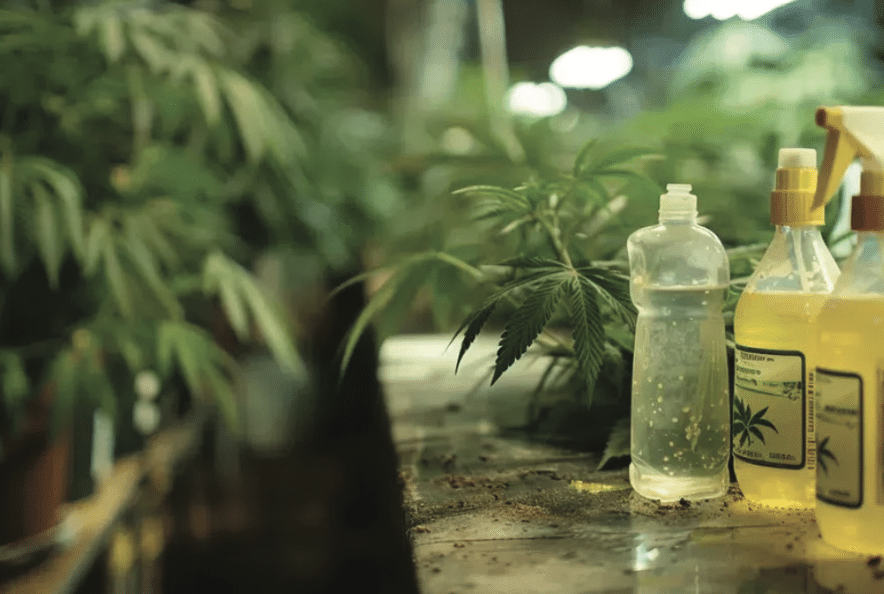When you are preparing for a first grow and/or preparing for the next run, cleaning, sanitizing, and sterilizing are some of the things a cannabis grower/cultivator must consider to ensure a healthy grow. It’s not enough to sweep, mop, and wash. Preparation of the space cannabis grows in requires many more considerations to ensure the space is clear of pests, mold, and mildew — cannabis plants love temperatures in the 70s and 80s, and so does fungus. Thoroughly cleaning and sanitizing in between runs can reduce the risk of a contaminated grow.
I chatted with five cultivators from around the country and with different expertise to get insight into preparing a space for the first grow and in between grows. Their insights and perspectives represent four decades of collective experience growing hemp and marijuana.
Please meet these cannabis cultivators, owners, founders, and leaders:
- George David Perez, owner of Hotbox Chicago (hotboxchicago.com, Illinois)
- Herbert Orlando Gonzalez, owner of Herbs Cali Krush LLC (herbscalikrushllc.com, California)
- Randy Rembert, owner of Rembert Family Farms (rembertfamilyfarms.com, Florida)
- Matt Gunter, owner of Busted Bucket Farm (linkedin.com/in/mattguntercannabis, North Carolina)
- Stephen Davidson, director of cultivation at Zenbarn Farms (zenbarnmj.com, Vermont)
Can you tell the first-time cultivator five things you considered, related to cultivating cannabis, before planting your seeds for your indoor grow?
George David Perez: The small-scale cannabis cultivation or “small batch craft grow” is one of the most exciting endeavors for seasoned growers and the novice alike. The object, of course, is to grow the dankest, most flavorful cultivars you ever smoked. You learn as you grow. Your last harvest is almost always better than your first harvest. Don’t put too much pressure on yourself, take joy in your grow. You will get better with every harvest. I considered the grow space. The total available space should dictate the specific cultivars you plan to grow. You don’t want to grow a high sativa-leaning cultivar in a shorter space because those cultivars tend to stretch more vertically when compared to indica-leaning cultivars. Form follows function. Consider the cultivar being grown. First-time growers should look for seed packs marked feminized. This will help avoid cross-pollination from male plants to female plants unless your goal is seed production or the creation of your own cultivars. Consider the grow medium/nutrients. Cannabis is colloquially referred to as “weed”; it is quite hardy and can grow almost anywhere. However, the medium you grow it in will directly affect the results of your plants’ performance. There are several choices like expanded clay pellets, potting soil, live soil, coconut coir, mixed media, etc. While some cultivars do well in any medium, some prefer certain mediums. Consider the air supply. Every living organism needs to breathe, and plants are no different. They need to take in CO2 and release O2. You can have the best tent and the best lights, but if you don’t supply enough fresh air your efforts will be curtailed in the end. Consider IPM. Integrated pest management is the term given to your program for mitigation or remediation of pathogens, pests, and pollen.
As an outdoor grower/farmer, what are three important things when you consider shifting from outdoor to indoor cultivation?
Randy Rembert: The first is cost because the sun is free, the beneficial bugs are free, the rain is free, and the wind is free. When you go indoors everything is controlled by you and will cost. This means the fans, nutrients, lights, watering, and more. The second thing is your plant schedule. Now that the environment is controlled, it will be up to you to decide when they go into flower, what the feeding schedule will be, when they will be watered, and what pest management will be. The third thing to consider is how much space you should use. Unlike outdoors, how many lights you have will determine the yield of your crop (there are other facts too, of course). This means your grow space should match what you can handle when it comes to lights, labor, AC, heating, and spacing.
As a grower in the South, what do new Southern region–based growers need to consider when setting up their indoor grow in between runs?
Matt Gunter: Each time you start a new grow or a cycle, you have the opportunity to get more control on the initial conditions that will set the course until harvest. I come from deep South, sun-grown cultivation so I am used to growing in the jungle. When it came to growing indoors, I had to change my perspective and step up my game. When I first went indoors, one of my OG mentors had to beat it into me to meticulously scrub, clean, and sanitize every surface and interface imaginable. Coming from the outdoors I thought he was crazy. I did not perceive all of the threat reservoirs coming from the most mundane places. He had us disassembling and scrubbing for days on a converted barn facility. Then we were sanitizing every imaginable surface, crease, crack, crevice, pipe, hose, basin, tube, etc. You had to get into a paranoid mindset on all the threat vectors and put in the elbow grease. After that exhaustive cleaning and sanitization, baseline biosecurity was established, and a one-way flow of plant material and inputs was established. Indoor nursery and experiment chambers flowed to the greenhouse, which then flowed outdoors. Because of that, all we ever experienced was some occasional algae and a few gnat wars over four years. These threats most likely occurred due to poor quarantine, storage, and inspection of incoming materials and plants. It once again showed me that in the Dirty South you better not store your growing medium and any other inputs outdoors and then bring it inside. With higher temperatures and humidity in the South, ensuring your building envelope is tight is important and the cultivator must test the equipment for the worst case as it relates to the building and equipment efficiency. Popping circuit breakers and rolling around air management units during peak summer heat with a potentially dead crop is always a challenge. It is best to simulate and monitor the equipment demands before the plants go in.
What light maintenance may be needed in between runs and/or what do you recommend checking that is often missed?
Stephen Davidson: As a new grower, once you find the light that works with your growing environment, you have to learn how to use it. More importantly, how to take care of it. Your ability to manage their temperature influence on your growing environment, coupled with their overall light intensity is vital to the success of your medium, and the quality of your product. I recommend purchasing a cheap temperature and humidity sensor to put in your tent, roughly around your canopy height, to have a good bearing on what your environment is like. Physically touching your ballast, while it’s running, is also a great way to get an idea of how hard you’re running your light. Depending on how you are creating your clones or sourcing your new plants, a dimmable, or even better, a digital controller, is a great way to start new crops. You can slowly scale your intensity of light up throughout a run, especially if transitioning clones from low light to your flowering lights. It’s always a healthy practice to clean your lights between runs. One as a biosafety of bugs, molds, and dust, but also a once-over on the light, its components, and operation. If you are running a digital controller, it’s great to test its ability to turn off and on when commanded. If you have a PAR sensor, it’s always a relief to double-check that you are producing what the light was designed to produce, as well as checking the PAR at canopy distance to the light. A halide or sodium bulb is a great way to determine how much life is left in your bulb.
Quality PAR sensors are very useful but can be pricey, wouldn’t it be nice if your local grow store rented those sensors out?
What do new growers often miss regarding HVAC?
Herbert Orlando Gonzalez: One thing is the HVAC and dehumidifier go hand in hand. They work together to control moisture, temperature, and humidity. I recommend changing the filters out before every run. There are also UV lights targeting germs. They can worsen conditions for your plants or seedlings if not properly cleaned. Not sanitizing lights can create gunk build-up, moving it through your HVAC system. Before you start the run, you want to clean the HVAC and dehumidifier, sanitize the blower, and always change the filters. Growers forget to change filters and that alone can change the health of your grow. Filters catch gunk. When you don’t change the filters it starts to block the airflow, and if there is airflow, it’s not clean. Not changing filters also makes the HVAC run harder because it’s forcing airflow through dirty filters.
This can damage the system, causing expensive repairs. It’s always better to have more cooling power than you need.
In addition to the valuable information shared already, here are some general considerations for cleaning, sanitizing, and sterilizing:
- Hydrogen peroxide is a great sanitizer.
- A vacuum with a HEPA filter is best.
- Bleach and water can kill pathogens.
- Protective gear is critical: goggles, gloves, and face masks.
Some considerations for what should be cleaned/sanitized/sterilized:
- Surfaces
- Walls
- Floors
- Ceilings
- Lights
- Pots
- Drip Pans


